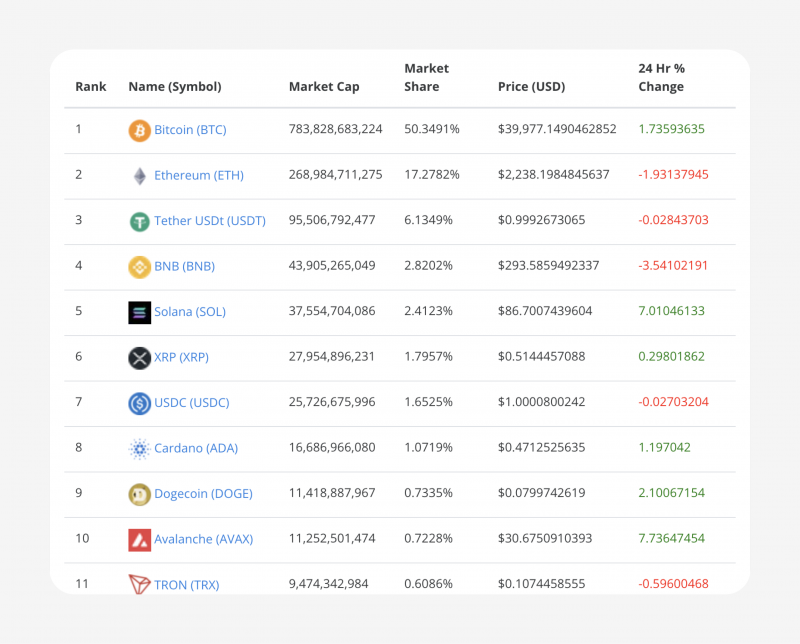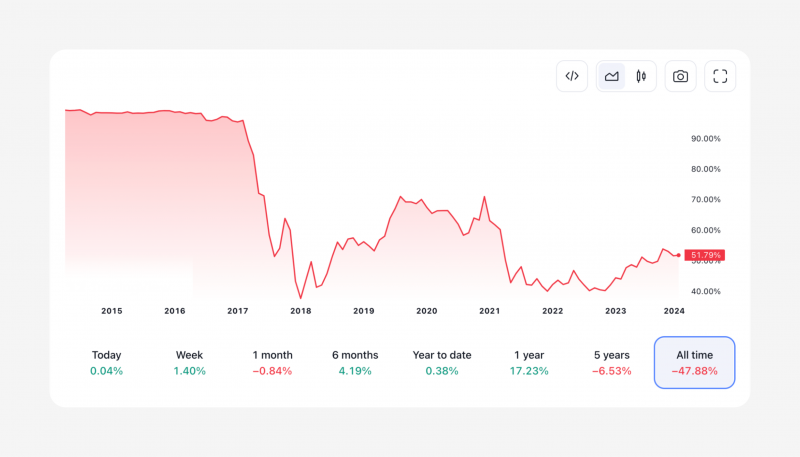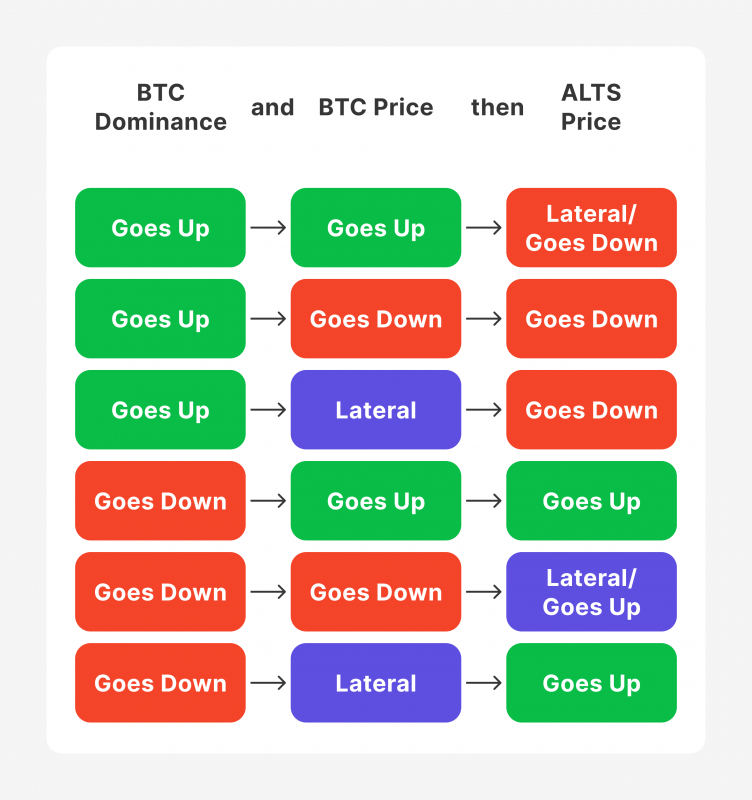The crypto market has tremendously progressed in recent years. Starting strong, then hitting two rocky sections of its young existence, crypto is in an excellent position to thrive in 2024. However, one coin has remained on the cryptocurrency ladder through all the trials and tribulations. Bitcoin is as dominant as ever within the crypto ecosystem in 2024, offering traders the most stable investment opportunity.
So, it is logical that BTC dominance, one of the most actively analysed crypto ratios, uses Bitcoin’s market cap as an anchor for its calculations. This article will discuss how the Bitcoin market cap influences the cryptocurrency market and why you should add the Bitcoin dominance chart to your daily trading analytics.
Key Takeaways
- The BTC dominance ratio is calculated by dividing Bitcoin’s market cap by the total crypto market cap figure.
- BTC dominance swiftly shows any changes in the crypto environment, possibly signalling bullish or bearish markets.
- Emerging altcoins can impact the BTC dominance ratio, crypto market disruptions and outside factors like the global economy or regulations.
- Many expats prefer the “real” BTC dominance ratio, which only uses the market cap of PoW altcoins in the calculation.
What is Bitcoin Dominance?
In simple terms, Bitcoin’s dominance ratio is a straightforward formula that calculates BTC’s market capitalisation divided by the total cryptocurrency market cap. To understand this formula thoroughly, we must first grasp the concept of market capitalisation. The market cap of any tradable asset simply calculates the total fair value of all available units.

To further visualise this concept, let’s swiftly calculate Bitcoin’s market cap by utilising the circulating supply and Bitcoin’s price. At the moment of writing, BTC’s price currently sits at approximately $42,000. As of 2024, BTC’s circulating supply has reached 19.6 million units. Now, we can multiply the two variables and come to around $825 Billion, roughly equivalent to today’s BTC valuation.
While market cap numbers are always available online, calculating this value is a trivial process you can comfortably do alone.
So, now that we have the concrete number of BTC market cap, it is time to calculate the BTC dominance ratio. For this, we must divide the BTC market cap by the overall crypto market cap number, which currently stands at $1.65 trillion.
As a result, the current BTC dominance ratio is 50%, showcasing just how significant Bitcoin’s presence is compared to the entire cryptocurrency market. Now that we have a firm grasp of the fundamentals, let’s discuss the significance and practical utility of crypto’s most famous ratio.

Why BTC Dominance Matters in Crypto Landscape
As discussed above, Bitcoin firmly remains the go-to cryptocurrency market. The BTC dominance ratio, aptly named the flagship currency, remains the most stable presence in the entire crypto market.
Through numerous challenges, Bitcoin has always managed to maintain a relatively strong and healthy market capitalisation, while other altcoins entered and exited the market due to various complications.
So, when Bitcoin’s literal dominance is challenged in any way, it is an excellent signal for new investment opportunities. Generally, the BTC dominance ratio falls whenever there is an ongoing bull market or the emergence of a new revolutionary coin or something else that is equally significant.
Therefore, the BTC dominance ratio shows when the crypto market is experiencing tectonic shifts, which is almost always a great chance to acquire long or short positions on specific assets.

It is easy to see why expert traders frequently employ BTC dominance since it is a clear signal for market changes. While this ratio is simple, it is very effective in the hands of adept investors, allowing them to adapt to changing market environments quickly.
What Factors and Variables Impact the BTC Dominance?
The BTC dominance ratio can change due to numerous variables and circumstances unravelling within and outside of the crypto market. However, there are some usual suspects that you can swiftly analyse.

New Coins that Disrupt the Market
The most obvious culprit in changing the BTC dominance ratio is the arrival of new altcoins. The crypto markets are still in their teenage years, meaning the industry is more than welcoming to up-and-coming currencies introducing new technology, utilities, smart contract functionality and other innovations. Every once in a while, a new crypto project enters the scene and accumulates massive hype behind its promising ideas.
When such altcoins get introduced, their initial valuation can increase rapidly and significantly impact the total crypto market cap. In most cases, the fresh altcoins experience a cycle of overvaluation and inevitable demise, all fueled by the hype surrounding the new technology.
The altcoin dominance window is relatively short in most cases. However, some altcoins have managed to pull through and establish a respectable market presence globally. Ethereum is an excellent example of this, emerging in 2014 and swiftly conquering a sizable chunk of the global crypto market cap.
Other Market Innovations
Aside from new altcoins, the crypto market has experienced many disruptions due to the solid technological basis of blockchain. NFTs, smart contract functionality, DAOs and stablecoin concepts are among the most famous examples of brand-new technologies bursting onto the scene and accumulating a massive market capitalisation. However, some innovations are more lasting than others.
While smart contracts have become a staple of the industry and the backbone of the market’s second most valuable coin, Ethereum, NFTs have become almost extinct in their original form.
Logically, not every innovation will permanently shift the BTC dominance ratio or even for a considerable time. In most cases, innovations are driven by hype and result in temporary BTC dominance changes, which industry experts almost instantly recognise.
The Emergence of Stablecoins
As a more specific example of the previous section, stablecoins changed the crypto market permanently in 2018, diluting the BTC dominance metric significantly. Stablecoins emerged as the safest and most regulated crypto alternative to the flagship currency, allowing investors to invest in crypto without enduring massive market volatility risks.
USDT and USDC were the first generation of stablecoins, challenging Bitcoin’s dominance unprecedentedly and taking up a significant portion of the market. The arrival of stablecoins even prompted the creation of a brand new ratio called the stablecoin supply ratio (SSR), which is calculated by dividing Bitcoin’s market cap by the total market cap of stablecoins.
While many other coins have faded into obscurity, stablecoins have prevailed due to their stable nature and simplified conversion to fiat. While their market share is only 8% in early 2024, their presence is growing steadily.
Political and Regulatory Influences
Numerous outside factors also impact the BTC dominance ratio, including political, regulatory and economic factors. Unforeseen anomalies sometimes work for or against Bitcoin’s dominance metric. The COVID-19 pandemic is an apt example of such a black swan event, effectively changing the global economy and eventually leading up to the most significant crypto bull run in history.
The recent regulatory trends are also significant factors, changing the entire makeup of the crypto ecosystem by introducing stricter KYC and anti-money laundering laws. Moreover, governments are actively discussing ways to limit the crypto market risks, which will inevitably impact the entire market. However, the altcoins will suffer more in this case, as Bitcoin is one of the more securely regulated cryptocurrencies already.
Finally, the success of the fiat sector has always been tightly linked to the crypto and, specifically, Bitcoin growth. Whenever the conventional markets experience volatility or uncertainty, many investors prefer to sell their crypto investments and return to the safer currency form. While this is not necessarily true in all cases, the public perception is strongly skewed toward trusting the fiat reserves.
All of the abovementioned factors can either increase or decrease the BTC dominance ratio, resulting in a favourable or unfavourable circumstance for investment opportunities. So, it is essential to understand the BTC dominance in the broader context instead of the narrow scope.
Analysing the BTC dominance ratio in a vacuum is not advisable, as it could lead to misleading conclusions. Instead, it is best paired with various analytics methodologies, like market sentiment analysis.
Practical Applications of BTC Dominance Charts
Naturally, there are numerous applications for the BTC dominance metric. Newcomers and experienced traders can analyse this ratio to understand what’s going on in the BTC domain and the general crypto market.
While industry leaders can devise complex Bitcoin trading strategies, BTC dominance can be understood simply. There are four possible outcomes when considering the relationship between BTC price and dominance metric. Let’s analyse each of these scenarios.

BTC Price Goes Up, and Dominance Goes Up
The first scenario is relatively straightforward, signalling another cycle where Bitcoin increases in value while other altcoins remain stagnant. In this case, a bull run is expected to happen, but only in relationship to the BTC coin. This outcome has occurred due to various reasons. Sometimes, BTC becomes popular thanks to the inflow of fresh investors who generally employ conservative trading strategies. Other times, this could be caused by positive developments surrounding the BTC coin, like new and improved security measures or regulatory trends.
BTC Price Goes Up, But Dominance Goes Down
The second outcome almost always indicates that a general bull run is emerging within the crypto field. If BTC’s price goes up, its market cap also increases. However, if the BTC dominance is still shrinking, this can only mean that other altcoins are expanding their valuation faster than BTC. So, the bull run is imminent or ongoing when this condition is met. The same is generally valid if the BTC price remains lateral.
BTC Price Goes Down, But Dominance Goes Up
This scenario is the inverse of the previous one, where BTC’s market cap is declining, but the rest of the market is suffering even more. This condition has always signalled the arrival of an altcoin bear market within the entire industry, and it mostly happens after the bull run cycle is over. It is difficult to conclude that BTC is doing well in this scenario since most bear markets have taken a brutal hit on BTC prices empirically. The same outcome occurs when the BTC price remains the same.
BTC Price Goes Down, Dominance Goes Down
The last possible outcome is the exclusive bear market for BTC itself, where the flagship coin could experience a bumpy road due to various circumstances. Generally, BTC bear markets don’t happen in a vacuum, and other coins suffer as well, but the market has witnessed rare occurrences when BTC could be hit the hardest. This phenomenon is mostly attributed to BTC’s lack of real utility and smart contract functionality.
So, if the bear market is all but certain, some investors might sell BTC sooner than they sell Ethereum since it offers strong core utilities with smart contracts.
Examining the “Real” BTC Dominance Charts and Their Utility
By now, you might have formulated a question: Is it fair to compare the BTC market cap with the remainder of the crypto market? Naturally, many other experts have asked the same question and decided to create a different formula, aptly named the “real” BTC dominance ratio. This formula and the corresponding chart eliminate cryptocurrencies that don’t directly compare to Bitcoin.
For example, this ratio does not include stablecoins, centralised currencies, or any crypto projects that don’t work with the proof-of-work (PoW) consensus mechanism. As a result, the “real” BTC dominance ratio looks like this:

While this formula can give a much clearer picture of BTC’s standing within the industry, it is far harder to calculate. There is currently no convenient way to track all PoW coins available on the market, and most of the popular index platforms only showcase the basic BTC dominance ratio.
For example, you can access the Bitcoin dominance tradingview chart in a matter of seconds and acquire an accurate ratio throughout the history of BTC’s existence. In the case of the “real” BTC dominance ratio, the options are much more limited. However, you can still find the “real” ratio on certain websites.
Final Thoughts
The Bitcoin dominance ratio is an essential tool for any aspiring crypto traders and entrepreneurs. This simple yet powerful metric can yield numerous useful insights and swiftly help you understand if the market is about to experience drastic changes.
While BTC dominance could signal many things, it is not difficult to interpret it and use it as a competitive advantage. However, the simplicity of BTC dominance also leaves a lot of room for interpretation.
So, before making any final investment decisions, be sure to double-check your conclusions with your peers or use complementary ratios to acquire more certainty.
FAQ
What does BTC dominance mean?
BTC dominance is a ratio that compares Bitcoin’s market capitalisation with the entire crypto market cap. It swiftly shows Bitcoin’s current impact and often signals possible market shifts.
Is Bitcoin's Dominance Going Down?
Bitcoin dominated the crypto market significantly in the early-to-mid 2010s. However, smart contracts and stablecoins’ emergence have drastically diluted Bitcoin’s overwhelming market share.
Why does Bitcoin dominance matter?
BTC dominance is a simple ratio that is useful to practically everyone in the crypto market. It can be analysed quickly and will reliably showcase if the market is experiencing any sort of change.











